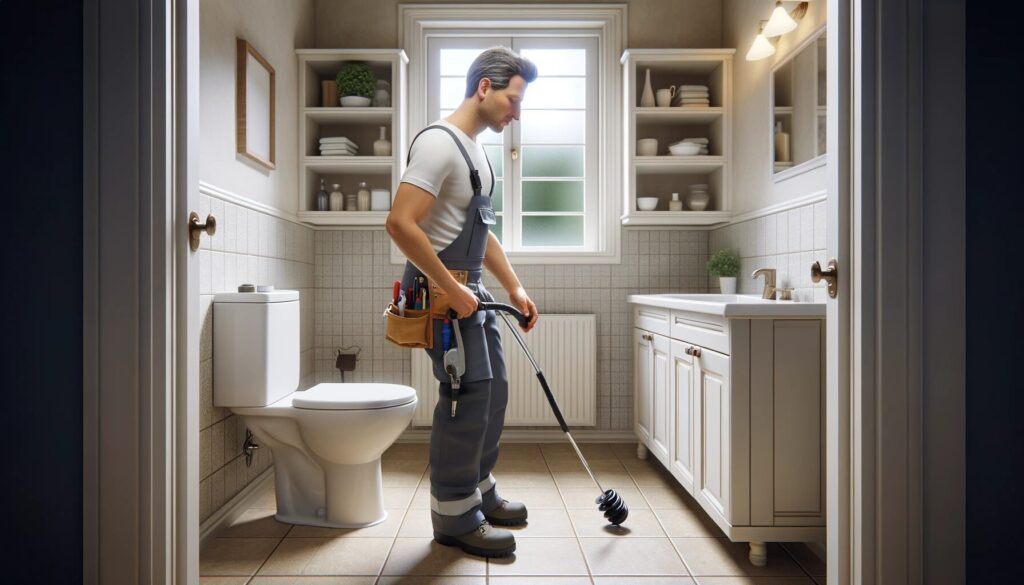Let’s jump straight into the essential toolbox of any home repair enthusiast or construction professional – the world of the toilet auger. This tool, also known as a closet auger, is a fundamental solution for those challenging toilet clogs that a regular plunger just can’t handle. It’s a practical, efficient solution that I’ve seen work wonders in both residential and commercial settings.

Understanding the Toilet Auger
Imagine this scenario: you’re faced with a stubborn blockage that your plunger is powerless against. This is where the toilet auger comes into play. It’s a specialized tool, uniquely designed for clearing out tough clogs deep within your toilet’s plumbing. Here’s a breakdown:
- Handle: This is where your control lies. It’s designed to provide a firm grip, allowing precise manipulation of the cable.
- Cable: This flexible yet sturdy component is the heart of the auger. It’s what snakes through the curves of your toilet’s plumbing to reach and dislodge clogs.
- Auger Head: At the forefront is the auger head, engineered to either break apart the obstruction or latch onto it for removal.
Toilet augers are particularly effective against physical obstructions such as excessive toilet paper, accidental flushes of small objects, and similar blockages. They’re not the solution for mineral deposits or deeper sewer line issues.
Preparing to Use the Toilet Auger
Before you tackle the clog, proper preparation is key:
- Workspace Preparation: Ensure a clear, accessible area around the toilet. Remove any items that might obstruct your movement.
- Safety Gear: Always wear gloves. Dealing with plumbing fixtures can be messy and unsanitary.
- Selecting the Right Auger: Augers come in various lengths. For most household toilets, a standard 3 to 6-foot auger is suitable.
- Protecting the Toilet Bowl: To avoid scratches, consider wrapping the auger head with duct tape or using a model with a rubber sleeve.
Step-by-Step Guide to Using a Toilet Auger
Now, for the hands-on part:
- Inserting the Auger: Carefully lower the auger head into the toilet bowl, angling it to minimize contact with the bowl to prevent scratches.
- Locating the Clog: Turn the handle clockwise to extend the cable. You’ll feel resistance when the auger reaches the clog.
- Engaging the Clog: Gently wiggle and rotate the handle. This action either breaks up the clog or hooks onto it for extraction.
- Clearing the Blockage: Pull out the clog slowly if hooked. If breaking it up, observe if water flow improves.
- Repeat as Needed: Persistence is key. If the first attempt doesn’t clear the clog, try again.
If multiple attempts don’t resolve the issue, it might be time to consult a professional. However, in most cases, a well-executed auger operation will do the trick.
Post-Augering Steps
Once the immediate challenge of the clog is resolved, it’s time for some essential follow-up steps to ensure the longevity of your tools and the hygiene of your space.
- Cleaning the Auger: Proper cleaning of your toilet auger is key to maintaining it. Rinse it thoroughly with water, using a brush and mild soap if necessary to remove any debris. This step not only maintains the auger but also prevents potential hygiene issues. Make sure to dry it completely to avoid rust.
- Sanitizing the Area: After dealing with a toilet clog, sanitizing the area is crucial. Use a reliable disinfectant to clean the toilet bowl and surrounding area. This step is not just about aesthetics; it’s about maintaining a sanitary environment in your bathroom.
- Prevent Future Clogs: An ounce of prevention is worth a pound of cure. Educate everyone in the household about what should and should not be flushed. Stick to the basics: human waste and toilet paper. Even items labeled as “flushable” can be problematic.
FAQ Section
The toilet auger’s mechanical advantage lies in its ability to reach deeper into the toilet plumbing, addressing clogs beyond the reach of a plunger. Its design allows it to physically break up or retrieve blockages, offering a more comprehensive solution.
Start with a plunger. If that fails, the auger is your next line of defense. If the auger doesn’t resolve the issue, especially if clogs are recurring, professional help may be necessary.
While a toilet auger is a powerful tool, it must be used with care to avoid damaging your toilet. Gentle and careful maneuvering is crucial to prevent scratches or damage to the porcelain.
Caution is advised with chemical drain cleaners, as they can be harsh on your plumbing and the environment. Often, mechanical removal of clogs is preferable and more environmentally responsible.
Regular cleaning after each use and periodic maintenance checks are recommended for your toilet auger. Proper storage in a dry area is also key to prevent rust and ensure its longevity.
